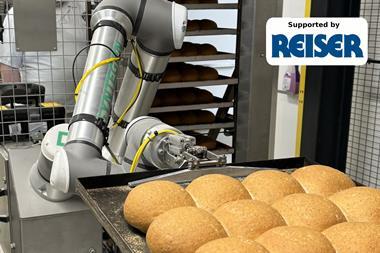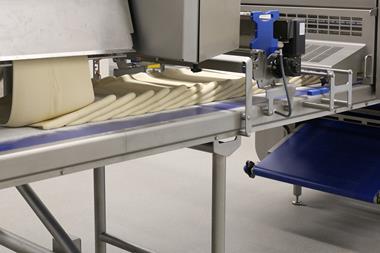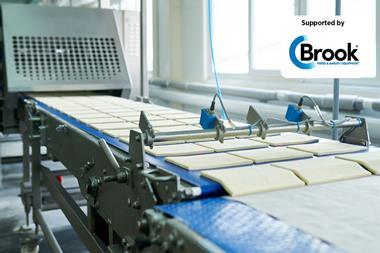When space is at a premium, retail bakers need to make the most of every inch. Here, shop design specialists give some tips on how best to utilise the area available… and maximise sell-through
Many shoppers have turned their backs on hypermarkets and soulless, warehouse-style stores in favour of personal service, unique products and a shopping experience.
It’s a retail climate that bakers – particularly those baking on-site – can thrive in. But how can a baker best show off their skills and wares if their bakery is closer to the size of a box office than a theatre?
To make the most of a small trading area, think carefully about the layout of the counters, ovens and equipment and how this influences staff and customer behaviour, says Ben Lord, buyer/estimator at bakery and coffee shop design specialists Frimovel.
“Which way should customers queue – is this clear? Does the shop traffic ‘flow’ easily? Do they get to see all the products on offer?”
Building counters in a straight line saves space, rather than having returns or corners, although this depends on the shape of the space. “A narrow shop front, but long in depth, would lend itself to running counters down the length of the shop, whereas a wide but shallow shop would allow counters facing the customer across the width,” says Lord.
Layout is not only about aesthetics, he adds. “When you have hot trays coming out of the oven, boiling hot cups of coffee, hot soup being served, staff making sandwiches to order, all potentially at the same time, this can end up being quite dangerous if serious consideration is not given to the smooth running of operations.”
Like a good kitchen design, a bakery should optimise an effective ‘working triangle’, according to retail expert Karl McKeever of Visual Thinking: “Think the window, the display counter and the rear counter wall and, crucially, integrating the point of sale or payment area within.
“Good interaction between these three design components is critical to maximising attractive product display, efficient service and daily sell-through,” he adds.
“But, don’t just impose a solution that you feel is right for your business,” advises David Martin, joint managing director, M Worldwide. “Instead, ask customers what they think and be prepared to change and adapt to ensure you’re meeting their needs.”
Counter displays should be shallow in depth on the customers’ side, open-glazed, and have a clean and clutter-free top surface to enable easy and personable service, says McKeever. For rear display counters, bread should be stored on open shelves to allow cooling, drying and easier crumb cleaning.
Frimovel suggests small sites can use a self-serve multideck display fridge for drinks and pre-made sandwiches. “Many of our customers, particularly Bird’s Bakery, have a lot of self-service bread displays in their shops, which leaves a smaller bread shelving display at the rear of the counters and means staff can serve customers quicker and more efficiently,” adds Lord.
“Customers should notice the products rather than the fittings,” he adds.
Less can be more, advises Richard Ford, director of new business at retail design consultancy Sherlock Studio: “Tempting as it is to cram shelves with product, allowing a display to breathe looks far better in a small space. Regular customers who come in for their usual ‘white tin loaf’ don’t really need to see it on a shelf,” he adds. “Instead, use the retail area to encourage people to trade up.”
As for the in-store theatre, showing the bakery production area can give customers a sense of trust and provenance. “If you’re baking on-site, in close proximity to your retail space, you’re sitting on retail gold,” says Ford. “Retailers dream up ‘in-store theatre’ to excite customers but, in a bakery, you already have that. Make the most of the sights, sounds and smells associated with baking bread. Don’t hide it away.”
Case Study: Roses the Bakers, Sheffield
Roses the Bakers in Sheffield had been supplying bread and other products to be sold in the local post office for a few years, when the post office itself became available.
The shop was very small, at just over 23 sq m, and there was no space for a preparation area. The project was only made viable because Frimovel was able to locate the kitchen/prep area in the basement, which was kitted out with ovens and prep fridges/freezers.
With the stairs to the basement encroaching the already small shop area, counters were made small and the salad prep counter put on the back wall (see 3D render). The upstairs area is all shop space – bread shelving on the back wall with the counters in front and self-serve bread and drinks on the right-hand side.
“To make [the post office] work for us, we felt we had to deliver our full offering – so we simply condensed everything,” says Roses general manager Mark Johnstone.
“Working with Frimovel, we have a smaller salad bar, a smaller cream fridge, and smaller heated counter, so that we can still display our full product range in a tight space, and we can also still offer great coffee.
“The downstairs is logistically not ideal, but it was the only way to make it work, so we had to compromise slightly.”


























No comments yet